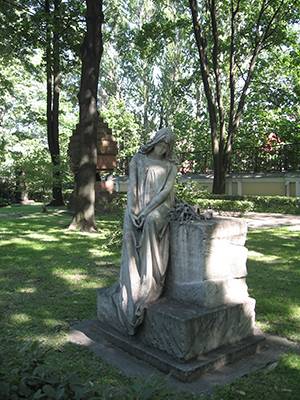
The Alexander Nevsky Monastery is at the very end of the main thoroughfare of St Petersburg, Nevsky prospect, and owes its name to Alexander Nevsky, the Russian national hero and patron Saint of St Petersburg. The Alexander Nevsky Monastery was founded by Peter the Great and and in 1797 (long after the death of the Russian Tsar) became one of only four in the Russian Empire to be given the title of Lavra, the highest rank in the Orthodox Church. As at all Orthodox monasteries, you won’t be allowed inside wearing shorts or skimpy clothing, but they don’t insist that women wear long skirts and headscarves.
On Lavras’s Tikhvin cemetery (for artists, poets, musicians, and actors) are the graves of Dostoevsky (“Crime and Punishment”,”Karamazov Brothers”), Tchaikovsky (it’s enough to mention his music to “Swan Lake”), Rubinstein (a piano player and the founder of the first Conservatory), Glinka (“ Life for the Tsar”- the first Russian national opera was written by him), Borodin, Nicholay Cherkassov (who played Ivan the Terrible in Eisenstein’s trilogy of films).
The second, Lazarev cemetery, was for rich and noble St Petersburg citizens but you can find there are also graves of architects who created St Petersburg, including Rossi (the Russian Musem and Alexader Theatre) and Voronikhin (Kazan Cathedral). The graves of many noble locals in Lazarev Cemetery are decorated with sculptures commissioned by their mourning relatives from Martos — outstanding Russian sculptor.
The nearby Trinity Cathedral is famous mostly for relics of Alexander Nevsky which are enshrined in a silver sarcophagus (a modest copy of the sumptuous original which is in the Hermitage). Behind Trinity Cathedral is Nikholsky Cemetery which is for the monastery’s scholars, priests and ordinary folk.
